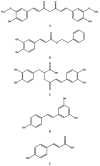The Role of the Nrf2/ARE Antioxidant System in Preventing Cardiovascular Diseases
- PMID: 28933413
- PMCID: PMC5456329
- DOI: 10.3390/diseases4040034
The Role of the Nrf2/ARE Antioxidant System in Preventing Cardiovascular Diseases
Abstract
It is widely believed that consuming foods and beverages that have high concentrations of antioxidants can prevent cardiovascular diseases and many types of cancer. As a result, many articles have been published that give the total antioxidant capacities of foods in vitro. However, many antioxidants behave quite differently in vivo. Some of them, such as resveratrol (in red wine) and epigallocatechin gallate or EGCG (in green tea) can activate the nuclear erythroid-2 like factor-2 (Nrf2) transcription factor. It is a master regulator of endogenous cellular defense mechanisms. Nrf2 controls the expression of many antioxidant and detoxification genes, by binding to antioxidant response elements (AREs) that are commonly found in the promoter region of antioxidant (and other) genes, and that control expression of those genes. The mechanisms by which Nrf2 relieves oxidative stress and limits cardiac injury as well as the progression to heart failure are described. Also, the ability of statins to induce Nrf2 in the heart, brain, lung, and liver is mentioned. However, there is a negative side of Nrf2. When over-activated, it can cause (not prevent) cardiovascular diseases and multi-drug resistance cancer.
Keywords: EGCG; Nrf2; antioxidants; cardiovascular diseases; multi-drug resistant cancer; resveratrol; transcription.
Conflict of interest statement
The authors declare no conflict of interest.
Figures
Similar articles
-
Green tea polyphenol (-)-epigallocatechin-3-gallate triggered hepatotoxicity in mice: responses of major antioxidant enzymes and the Nrf2 rescue pathway.Toxicol Appl Pharmacol. 2015 Feb 15;283(1):65-74. doi: 10.1016/j.taap.2014.12.018. Epub 2015 Jan 10. Toxicol Appl Pharmacol. 2015. PMID: 25585349
-
The Effects of Dietary Supplements that Overactivate the Nrf2/ARE System.Curr Med Chem. 2020;27(13):2077-2094. doi: 10.2174/0929867326666190517113533. Curr Med Chem. 2020. PMID: 31099320 Review.
-
Epigallocatechin gallate potentially abrogates fluoride induced lung oxidative stress, inflammation via Nrf2/Keap1 signaling pathway in rats: An in-vivo and in-silico study.Int Immunopharmacol. 2016 Oct;39:128-139. doi: 10.1016/j.intimp.2016.07.022. Epub 2016 Jul 26. Int Immunopharmacol. 2016. PMID: 27472294
-
Modulation of Nrf2-mediated antioxidant and detoxifying enzyme induction by the green tea polyphenol EGCG.Food Chem Toxicol. 2008 Apr;46(4):1271-8. doi: 10.1016/j.fct.2007.10.006. Epub 2007 Oct 17. Food Chem Toxicol. 2008. PMID: 18082923 Review.
-
Epigallocatechin-3-gallate prevents oxidative stress-induced cellular senescence in human mesenchymal stem cells via Nrf2.Int J Mol Med. 2016 Oct;38(4):1075-82. doi: 10.3892/ijmm.2016.2694. Epub 2016 Aug 1. Int J Mol Med. 2016. PMID: 27498709 Free PMC article.
Cited by
-
Role of ferroptosis in hypoxic preconditioning to reduce propofol neurotoxicity.Front Pharmacol. 2023 Feb 2;14:1121280. doi: 10.3389/fphar.2023.1121280. eCollection 2023. Front Pharmacol. 2023. PMID: 36817119 Free PMC article.
-
Potential Nutrients from Natural and Synthetic Sources Targeting Inflammaging-A Review of Literature, Clinical Data and Patents.Nutrients. 2021 Nov 13;13(11):4058. doi: 10.3390/nu13114058. Nutrients. 2021. PMID: 34836313 Free PMC article. Review.
-
Upregulation of Nrf2 and Decreased Redox Signaling Contribute to Renoprotective Effects of Chemerin Receptor Blockade in Diabetic Mice.Int J Mol Sci. 2018 Aug 19;19(8):2454. doi: 10.3390/ijms19082454. Int J Mol Sci. 2018. PMID: 30126255 Free PMC article.
-
Study of the Antioxidant Properties of Filipendula ulmaria and Alnus glutinosa.Plants (Basel). 2022 Sep 16;11(18):2415. doi: 10.3390/plants11182415. Plants (Basel). 2022. PMID: 36145820 Free PMC article.
-
The role of oxidative stress in aortic dissection: a potential therapeutic target.Front Cardiovasc Med. 2024 Jul 12;11:1410477. doi: 10.3389/fcvm.2024.1410477. eCollection 2024. Front Cardiovasc Med. 2024. PMID: 39070552 Free PMC article. Review.
References
-
- Rice-Evans C.A., Miller N.J., Paganga J. Antioxidant properties of phenolic compounds. Trends Plant Sci. 1997;2:152–159. doi: 10.1016/S1360-1385(97)01018-2. - DOI
-
- Llorent-Martínez E.J., Fernández-de Córdova M.L., Ortega-Barrales P., Ruiz-Medina A. Characterization and comparison of the chemical composition of exotic superfoods. Microchem. J. 2013;110:444–451. doi: 10.1016/j.microc.2013.05.016. - DOI
Publication types
LinkOut - more resources
Full Text Sources
Other Literature Sources
Research Materials



